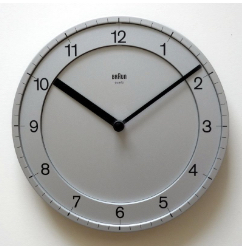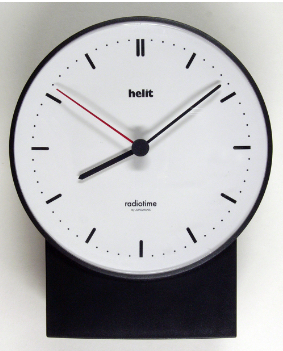Measurement Study Guide for the Math Basics
Page 2
Measuring Time
Maybe you’ve seen movies like The Time Machine, Back to the Future, or Interstellar. All of these focus on the idea of time travel: the ability to travel through the \(4^\text{th}\) dimension (time) as easily as we do the other three (3-D space). This topic is heavily studied and theorized currently, but among the common people, time is a one way, evenly spaced dimension.
Using a Clock
Around the world, we use the same units to measure time:
\[60 \; \text{seconds} = 1 \; \text{minute}\] \[60 \; \text{minutes} = 1 \; \text{hour}\] \[24 \; \text{hours} = 1 \; \text{day}\]Analog clocks tell time with the hour first, followed by the minutes, separated by a colon. For instance, three twenty-five would be 3:25. Parts of the world use a.m. (midnight to 11:59 in the day) and p.m. (noon to 11:59 at night) and the rest use a 24-hour clock. To convert from anything over 12:59 on the 24-hour clock, simply subtract 12 from the hour. So, 18:45 = 6:45 p.m.. To go the other way (only from p.m.), just add 12. Note: 5:27 a.m. = 5:27 on the 24 hour clock, but 5:27 p.m. = 17:27.
When reading a clock, first, pay attention to the shorter (usually fatter) hand. This is the hour hand. It will usually be between two numbers. In this case, choose the number immediately before it (counterclockwise from it). This will be the hour.
Next, look at the longer hand. This is the minute hand. Between each number on the clock, there are 4 ticks (5 parts). So each hour marking corresponds to 5 minutes. When looking at the minute hand, the number 1 means 5 minutes, 2 means 10 minutes, 3 means 15 minutes, etc. To speed up your minute reading skills, 15 minutes means the minute hand is pointing directly right, 30 minutes means it’s pointing straight down, and 45 minutes means it’s pointing straight to the left.

Retrieved from: https://upload.wikimedia.org/wikipedia/commons/f/f2/Braun_ABW41_%28silber%29.jpg
This clock (above) shows the time 10:09.
Occasionally, clocks have a second hand too. It is about as long as the minute hand, but much thinner and it moves faster. Read it the same way you’d read the minute hand.

Retrieved from: https://upload.wikimedia.org/wikipedia/commons/d/dd/Radio-clock_hg.jpg
This clock above (without the red second hand) shows a time around 8:09. The second hand shows that it’s actually 9 seconds until 8:09, so the real time is actually still 8:08:51.
There are a few sayings we use instead of constantly referring just to the numbers. For instance noon means 12:00 p.m. (midday) while midnight means 12:00 a.m. (or 0:00). We’d say half past three to indicate that half an hour (30 minutes) has gone since 3:00, so half past 3 means 3:30. Note: in the UK, they use half three instead of half past three to mean the same thing. We’d say quarter til to mean there is a quarter of an hour (15 minutes) until the next one, so, quarter til 8 means 7:45.
Using a Calendar
Much of the world uses the standard 12 month Gregorian calendar, which splits the year into 365 days. Not all months are equal though:
\[\begin{array}{|c|c|} \hline \textbf{Days} & \textbf{Months} \\ \hline 31 & \text{January} \\ \hline 28 & \text{February} \\ \hline 31 & \text{March} \\ \hline 30 & \text{April} \\ \hline 31 & \text{May} \\ \hline 30 & \text{June} \\ \hline 31 & \text{July} \\ \hline 31 & \text{August} \\ \hline 30 & \text{September} \\ \hline 31 & \text{October} \\ \hline 30 & \text{November} \\ \hline 31 & \text{December} \\ \hline \end{array}\]Note: Sometimes February has 29 days (once every 4 years). This is called a leap year and it occurs because the earth doesn’t rotate exactly 365 times each orbit around the sun.
When writing dates (in much of the world including the U.S.A.), use this format month/day/year. So, If you were born on April 18th, 1986, (April is the 4th month), you’d write 04/18/86 or 4/18/86. Pay attention when traveling, though! Many other countries use the format day/month/year.
When looking at a calendar, you’ll notice days are arranged in columns of 7. Each column corresponds to a certain day of the week. So, there are 7 days in a week and just over 52 weeks in a year. The days of the week are Sunday, Monday, Tuesday, Wednesday, Thursday, Friday, and Saturday. Saturday and Sunday are typically called the weekend while the rest are weekdays.
Measuring Weight
All objects have mass, but when earth pulls on that mass, weight can be measured. For instance, you weigh a certain amount, but if you were on the moon, you would weigh less. However, your mass hasn’t changed. In this section, you’ll see common units and conversions. To learn how to convert, read the Dimensional Analysis section at the end of this study guide.
Again, the units we use to weigh an object are different in the U.S. compared to most of the rest of the world. Here are some common U.S. standard weights and abbreviations:
\[1 \; \text{pound} = 16 \; \text{ounces}\] \[1 \; \text{ton} = 2,000 \; \text{pounds}\] \[\begin{array}{|c|c|} \hline \textbf{Unit} & \textbf{Abbreviation} \\ \hline \text{ounce} & \text{oz} \\ \hline \text{pound} & \text{lb} \\ \hline \end{array}\]Here are some common metric weights and abbreviations.
\[1 \; \text{gram} = 1000 \; \text{milligrams}\] \[1 \; \text{kilogram} = 1000 \; \text{grams}\] \[1 \; \text{tonne} = 1000 \; \text{kilograms}\] \[\begin{array}{|c|c|} \hline \textbf{Unit} & \textbf{Abbreviation} \\ \hline \text{gram} & \text{g} \\ \hline \text{kilogram} & \text{kg} \\ \hline \end{array}\]To convert between metric and standard:
\[1 \; \text{kilogram} = 2.205 \; \text{pounds}\] \[1 \; \text{ounce} = 28.35 \; \text{grams}\] \[1 \; \text{tonne} = 1.1 \; \text{ton}\]All Study Guides for the Math Basics are now available as downloadable PDFs